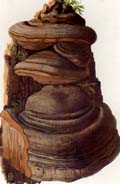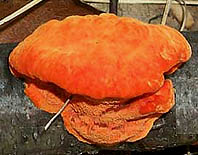Pycnoporus cinnabarinus
 Key to Gilled Mushrooms Key
Key to Gilled Mushrooms KeyThis is a key to gilled mushrooms, that is, mushrooms having a definite cap with a fertile surface consisting of gills. The fruiting body usually also has a stem, although that may be lateral or absent (usually, then, the mushroom is growing from wood). You can use this key to identify mushrooms that you find.
 Polyporaceae Family
Polyporaceae FamilyFertile surface usually a layer of vertical tubes, of which the mouths are visible as pores on the underside of the cap or shelf.
Fruiting bodies usually tougher or harder than the "normal" gilled mushrooms, being leathery, corky, or woody. But they can be quite tender while actively growing
Once grown, they do not decay easily, remaining on the substrate for months or years
They often grow on wood, although a few are terrestrial (even those are usually growing on buried wood)
Fruiting body is usually a flat shelf, or hoof-shaped, protruding directly from the substrate, although sometimes it may have a short stalk.
Some forms never grow away from the substrate at all, so that all that is visible of the fruiting body are the pores.
Sometimes the pores are so minute that the fertile surface seems solid, until you look closely
 Lignicopolypore Subfamily
Lignicopolypore SubfamilyGrowing on wood
 Red Polypore Tribe
Red Polypore TribeThe pores red, pink, or orange-red, or the cap at least partially one of those colors
Red Pore Polypore SubtribePore surface red, pink or red-orange; cap at least partially concolorous: often completely so, but sometimes just a band around the edge
Fruiting body very tough to hard
 Pycnoporus Genus
Pycnoporus GenusCap up to 5" wide, bright orange red or scarlet, pores bright scarlet; entire fruiting body changing to magenta or black with KOH.
Cap may fade from weather, but pores usually stay bright
Here are the characters that distinguish this species from the others in its group. For its more general characters, see higher up on the page.
If there's just a few words or a microscopic feature here, a more thorough description can be found above.

Diagnosis
- Cap up to 1.5 cm thick, softer than Pycnoporus sanguineus when fresh
-
Cap surface orange red, becoming pale (sometimes blackening) upon exposure to weather
-
Found everywhere






 Key to Gilled Mushrooms Key
Key to Gilled Mushrooms Key Polyporaceae Family
Polyporaceae Family Red Polypore Tribe
Red Polypore Tribe Pycnoporus Genus
Pycnoporus Genus





